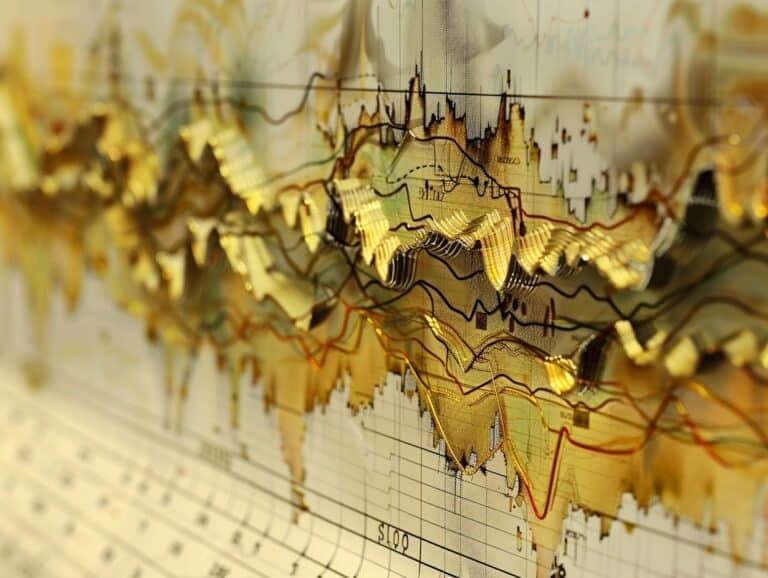Gold prices are nearing historical highs amid expectations for U.S. Federal Reserve interest rate cuts and prevailing economic uncertainty.
Short Summary:
- Gold prices are close to all-time highs driven by rate-cut speculations and a weaker dollar.
- Central bank purchases and investor interest are boosting gold demand.
- Economic uncertainties fuel safe-haven assets like gold.
The price of gold has recently approached its historic peak, driven by increasing anticipation that the U.S. Federal Reserve will implement interest rate cuts in the near future, coupled with ongoing economic concerns. As of the latest session, spot gold dipped slightly by 0.2% to $2,462.85 an ounce, tapering off from an earlier high of $2,482.29. Meanwhile, U.S. gold futures remained steady at $2,461.88.
“The expectation that we are getting closer to a Fed interest rate cut and we’ve seen this as yields continue to slowly grind lower in anticipation, that, along with a weaker dollar, are the main supportive factors behind this gold move,” said David Meger, Director of Alternative Investments and Trading at High Ridge Futures.
Market experts and policymakers alike have indicated a growing comfort with the current rate of inflation heading back towards the Federal Reserve’s target. Fed Governor Christopher Waller noted that the time for an interest rate cut “is drawing closer,” although uncertainties about the economic trajectory make it unclear exactly when rates might drop. The CME FedWatch Tool reflects a 98% probability of an interest rate cut in September.
Lower interest rates typically reduce the opportunity cost of holding non-yielding assets like bullion and exert downward pressure on the dollar, making gold more attractive to investors holding other currencies. Notably, the U.S. dollar recently weakened by 0.4% to near a four-month low against a basket of other currencies.
Another dimension adding to gold’s bullish run is increased central bank purchases and heightened investor appetite. David Meger also highlighted that central banks are becoming more strategic in their acquisition plans, with price fluctuations impacting the pace of their buying activities. This is particularly significant in light of China’s temporary halt on gold reserve purchases in May, which ended an 18-month buying streak.
“We think the price level of gold has minimal impact on long-term central bank acquisition plans; however, price changes do appear to influence the pace and cadence of net purchasing,” added Meger.
While central bank commitments remain steadfast as major buyers, personal investors are also contributing to the demand surge. Gold holdings in ETFs have been on a downward trend since mid-2022, but there is an expectation that a re-lengthening of investor ETF holdings will positively influence the physical gold market. A turnaround in ETF inflows could significantly tighten the market, driving gold prices even higher.
“While gold price movements may be fully decoupled from real yields and Fed pricing for now, we still think this would add an extra pillar of support later this year mainly through an eventual shift back towards retail ETF inflows, as money market funds become less attractive,” said Shearer, a market analyst.
Interestingly, the European Central Bank (ECB) recently left interest rates unchanged, and mixed economic data from the United States has compounded the uncertainty. For example, initial jobless claims for mid-July surprisingly rose to 243,000, exceeding the expected 230,000, whereas the Philadelphia Fed Manufacturing Survey improved significantly, indicating fluctuating economic conditions.
Emerging trends in commodities indicate a more bullish outlook for gold in the coming quarters, bolstered not only by lower anticipated interest rates but also by ongoing robust demand and supply constraints. Industrial metals, energy, and agricultural commodities exhibit diverse behaviors but generally showcase stronger demand trends fueled by economic resilience and geopolitical factors.
In particular, central banks’ continued robust purchasing, coupled with speculative buying in anticipation of Federal Reserve rate cuts, are substantial factors driving gold’s price upward. Notwithstanding the minimal decoupling from historical trends linking gold to real yields and U.S. dollar strength, the broader market sentiment remains decidedly positive.
“Gold prices have already jumped higher even as ETF holdings have continued to sag, and a turnaround here could be quite bullish, driving another sustained leg higher in prices,” Shearer reiterated.
With the current landscape marked by vigorous central bank activity, substantial investor interest, and economic uncertainties, the outlook for gold remains promising. The balance of factors such as expected lower bond yields, geopolitical tensions, and solid demand cement gold’s position as a safe haven asset, reinforcing its potential for sustained gains as we move towards the latter part of 2024.
Authors & Disclosures
- Our content is independently written and reviewed by trusted reviewers & fact-checkers.
- We can earn money by connecting you with top Gold IRA Companies. Learn how our reviews work.
- Want to learn more? Meet our authors and explore our editorial policy.


.jpg_00.jpeg)



